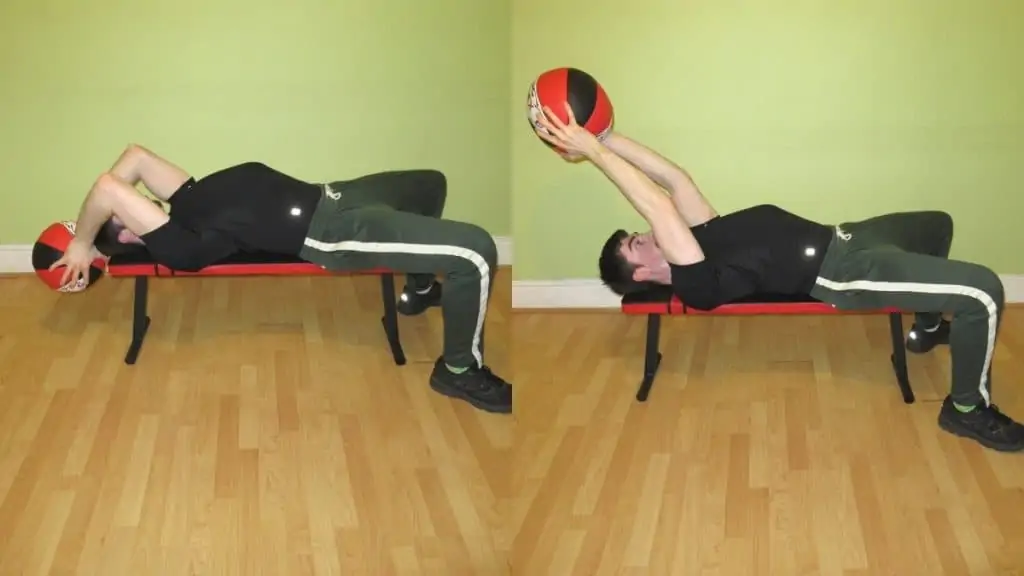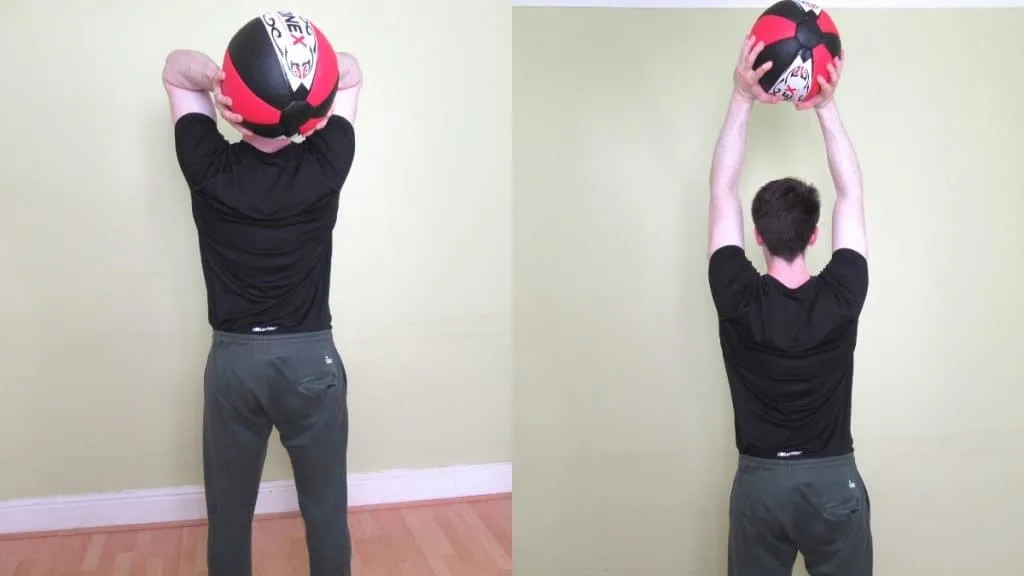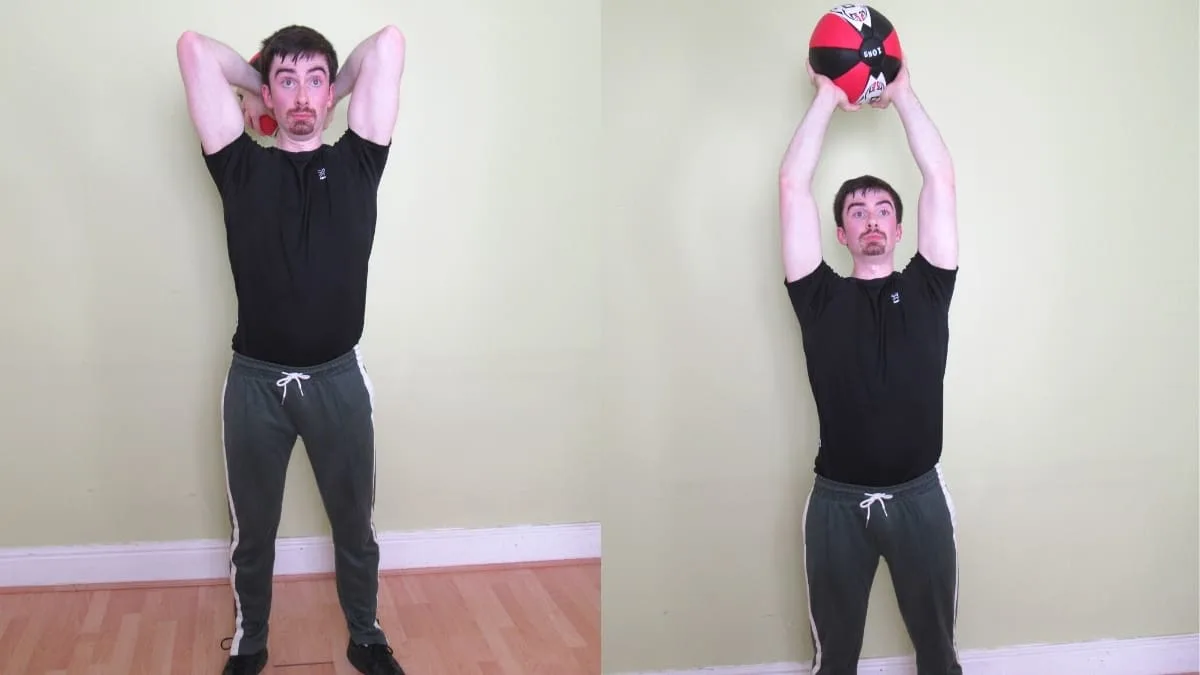Understanding how your triceps brachii works is crucial for building and toning your upper arms because the triceps accounts for two-thirds of your arm size.
Thankfully, learning how to maximize your tricep training efforts isn’t complicated.
All you need to know is that the triceps have two functions; elbow extension, which is performed by all three heads of the triceps, and shoulder extension, which is performed exclusively by the long head, the largest head of the triceps.
The medicine ball French press is a highly effective exercise in this regard because it trains both tricep functions simultaneously by having you perform elbow extension while your arms are over your head.
This French press workout guide includes 5 med ball French press variations that you can do to train your triceps and make them grow.
Medicine ball French press exercise details
- Main Muscles: Triceps
- Exercise Type: Strength
- Exercise Mechanics: Isolation
- Difficulty Level: Intermediate
- Equipment Needed: Medicine ball
How to do a medicine ball French press

- Grab a medicine ball and stand up straight.
- Press the ball over your head so that your arms are fully extended.
- Slowly lower the medicine ball behind your head by bending your elbows.
- Descend until you feel a strong stretch in your triceps.
- Flex your triceps to reverse the motion and keep lifting until your elbows are completely extended.
- Perform 3-5 sets of 10-20 reps in total.
Medicine ball French press variations
Here are 4 more med ball French press drills that you can do to build your triceps. Learn the pros and cons of each variation in the upcoming section to find out which exercise is best for you.
Seated med ball French press

The seated medicine ball French press is a tricep isolation drill in the purest sense of the term.
Because the bench’s backrest effectively does the stabilization work that your torso would normally have to perform during the standing version of the exercise, the seated med ball French press enables you to dedicate 100% of your attention to training your triceps.
The trade-off is that you’ll burn fewer calories when you do the exercise sitting down because your leg muscles and abs won’t be as active as when you’re stood up.
But for giving your triceps the best possible isolation, the seated medicine ball French press is one of the most effective exercises out there.
The only real downside is that you can’t increase the weight as efficiently as you can during the seated BB French press. This is because most medicine ball sets don’t ascend in small increments. As such, your best bet is to stick with free weights and cables for the bulk of your exercises and then do the med ball French press for some triceps pump work toward the end of your session.
Kneeling med ball French press

Performing the medicine ball tall-kneeling or half kneeling French press is a great way to improve your isometric ab strength while training your triceps dynamically.
The tall-kneeling position is more challenging than the half-kneeling position because it requires more abdominal exertion in order to keep your torso stable and upright.
So if you want to work your core to the max, definitely go with the tall kneeling med ball French press.
The half-kneeling version works your core to a lesser extent but makes it easier to keep the focus of the exercise firmly on your triceps. It also works your quads in an isometric fashion because your thighs are used to keep your body balanced.
Lying med ball French press

The lying med ball French press requires less core stability than the standing version of the exercise and, as such, is ideal if you want to focus purely on working your triceps.
The lying medicine ball French press is also a remarkably versatile and accessible exercise because, if you don’t have access to a bench, then you can do the movement on the floor instead.
Just make sure to keep a firm grip on the medicine ball; you don’t want the ball to fall out of your hands when you’re lowering it over your face!
This is one reason why sticking to the free-weight version of the French press is generally the best idea from a safety perspective. While dumbbells and barbells can certainly put a lot of pressure on your elbows during single-joint exercises, at least they enable you to hold the implement with a secure grip, which significantly reduces the chance of the weights slipping out of your hands mid-set.
Medicine ball French press on an exercise ball

Performing an exercise ball French press with a medicine ball is a good exercise to do if you don’t have access to a bench (or if you don’t fancy venturing into the free weight area to use one at the gym).
You can lie on the stability ball to involve more of your ab muscles, or you can sit directly on the ball to keep the focus of the exercise more or less on your triceps exclusively.
Of course, if you’re lifting a seriously heavy medicine ball, then even sitting on the middle of the exercise ball is still going to challenge your abs isometrically because it’s not like exercise balls have a backrest that can stabilize your torso.
Conclusion: Who should do a French press with a medicine ball?

If you don’t fancy spending time hunting down a particular pair of dumbbells or loading a precise amount of weight onto a barbell—in other words, if you just want to get on with training your triceps—then the medicine ball French press is a convenient and effective muscle-building exercise that will make your workouts less of a chore.
Although medicine balls don’t allow for the fluid progressive overload that’s characteristic of free weights, they’re easy to pick up and start lifting, which means that you can spend more time exercising and less time on the setup.
Performing a French press with a medicine ball is generally safe when you use the proper form. Just be sure to hold the med ball firmly so that it doesn’t slip out of your hands when you’re lifting. In this regard, it’s best to use medicine balls that have a rubber coating rather than a plastic one because rubber is far more grippable.

